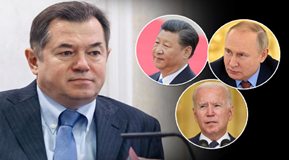The United States has had the privilege of dominating the global monetary system since 1944’s Bretton Woods agreement.
It’s often presented to the public like it’s the natural order of things, such as the law of gravity.
Or that it’s a given… like oxygen will always be there to breathe.
This assumption-based narrative leads people to think that the rest of the world is happy with the U.S. being the global reserve currency.
Nothing could be further from the truth.
The U.S. must vigilantly maintain U.S. dollar hegemony. And the playbook looks like this:
- The U.S. can devalue the Federal Reserve note “dollar” to oblivion while other countries receive it in exchange for their tangible goods and hold it in reserve.
- The U.S. can confiscate other countries’ assets and currency reserves because of our military advantage. That is what just happened with Russia.
- The U.S. can also block other countries from using the global financial system (SWIFT) it set up and controls.
Naturally, many countries are look for ways to exit this type of system.
The de-dollarization process is well underway and now involves far more countries than the U.S. expected. Even Saudi Arabia, the key country in the petrodollar, is beginning to trade outside the dollar and accept the Chinese yuan.
Golden Ruble 3.0 – Courtesy of Russian Economist Sergey Glazyev
Russia believes the “gold-pegged ruble” is part of the strategy to topple the U.S. dollar on the World stage. Here is how it came into existence…
Russian economic advisor to Putin, Sergey Glazyev, was one of the first people the U.S. sanctioned during its prior round of sanctions in 2014.
This was quite mysterious because Glazyev isn’t an oligarch or military general. He is an economist and the architect of Russia’s new monetary system, aka the Golden Ruble 3.0.
“The more aggressive the Americans are the sooner they will see the final collapse of the dollar as the only way for the victims of American aggression to stop this aggression is to get rid of the dollar.
“As soon as we and China are through with the dollar, it will be the end of the United States’ military might,” Sergey Glazyev said in 2017.
Gold and Silver: Industry-Best Customer Service at Money Metals (Ad)
Glazyev has more recently stated, “In the face of sanctions, Russia’s task is not to learn to play by the crooked rules of the West but to build transparent and mutually beneficial rules of trade with friendly countries, to create their own pricing systems, exchange trading, and investment.”
Glazyev continued, “Gold will be a unique tool in the fight against Western sanctions inclusive of all major international commodities (oil and gas, food and fertilizer, metals and solid minerals).”
After newsanctions in 2022 from the West, including kicking Russia out of the London Bullion Market Association (LBMA), Moscow began launching its own bullion exchange to trade in physical gold with its allies.
The Challenge of Trade Deals with “Soft” Currencies
Many members of BRICS countries are beginning new trade agreements with one another outside the U.S. dollar system using “soft” currencies like rupees and rubles.
But the use of “soft” currencies can be tenuous. For example, Russia may tell India, “you can buy our oil, and we will accept your rupees.” India may agree to accept Russian rubles.
This system is flimsy because as more countries participate, nations begin collecting a lot of currencies they don’t need and will have to unload in the forex markets.
Also, nations don’t trust each other (counterparty risk), so gold is the perfect medium of exchange and is a measure to limit the abuse by the world reserve currency issuer.
Sergey Glazyev and his eastern and southern partners are seizing this unique chance to “jump off” the sinking ship of the dollar-centric debt economy.
Glazyev stated, “The sanctions imposed on Russia have boomeranged the Western economy. In 2023, all these circumstances will objectively affect the change in the stereotypes of investment policy in the World — from risky investments in complex financial instruments to investing in traditional assets, primarily gold.”

Sergey Glazyev (left), Russian economist and architect of the gold-pegged ruble.
Glazyev continued, “Large gold reserves allow a country to pursue a sovereign financial policy and minimize dependence on external creditors. The amount of reserves affects the country’s reputation, credit rating, and investment attractiveness. Moreover, large reserves make it possible to plan the state budget for a long time, stopping many economic and political risks.”
Gold Scoreboard
- Gold’s estimated market cap is $12.1 trillion (by multiplying the current gold price by the world’s above-ground gold reserves.)
- BRICS are estimated to hold over 80% of this $12.1 trillion in gold.
- India (the citizens, not the government) are the largest collective owners of gold, with more than 50,000 tons of gold.
- China’s government is likely to have over 20,000 tons of gold.
Unanswered Questions
- Has gold remained in the vaults of Western Central Banks? Has it been encumbered through swaps and leasing?
- Will Fort Knox be credibly audited?
Jon Forrest Little graduated from the University of New Mexico and attended Georgetown University’s Institute for Comparative Political and Economic Systems. Jon began his career in mining industry and now publishes “The PickAxe” which covers topics surrounding precious metals, energy, history, and politics.
Source: Money Metals
Become a Patron!
Or support us at SubscribeStar
Donate cryptocurrency HERE
Subscribe to Activist Post for truth, peace, and freedom news. Follow us on SoMee, Telegram, HIVE, Flote, Minds, MeWe, Twitter, Gab, What Really Happened and GETTR.
Provide, Protect and Profit from what’s coming! Get a free issue of Counter Markets today.


Be the first to comment on "Could Golden Ruble 3.0 Knock Out the U.S. Dollar?"